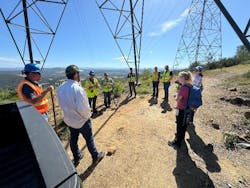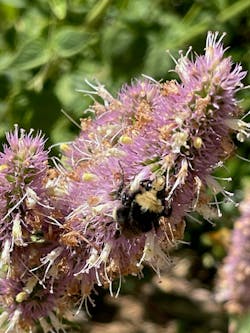Ecological Stewardship in Utility Corridors: Supporting Biodiversity and Native Plants
Listen to the Audio Story
In the heart of El Dorado County and the Sierra Nevada foothills, electric transmission corridors for Sacramento Municipal Utility District (SMUD) showcase environmental stewardship. Among granite outcrops and clearings, an ecosystem flourishes. The landscape features purple Giant Hyssop spikes, while the yellow blooms of Layne’s Butterweed — a rare species found nowhere else — grace the understory.
The work of maintaining these biodiversity efforts is substantial and ongoing, requiring broad-based support and coordination among multiple parties to achieve lasting success.
For example, the Pine Hill Preserve represents a remarkable example of biodiversity, hosting eight rare plant species, with four being endemic — found nowhere else on Earth. This makes preserves not just a corridor for common species, but a sanctuary for uniquely adapted flora that have evolved to thrive in these specific conditions.
SMUD manages more than 1,000 acres of rights of way (ROWs) and corridor space across diverse landscapes in Northern California. The creation and proper maintenance of ROWs and utility corridors can have positive ecological impacts, encouraging diverse flora and fauna in many instances.
Additionally, these areas can act as corridors for wildlife, facilitating movement and gene flow between fragmented habitats. With integrated and focused vegetation management (IVM), these corridors can be additionally programmed to support more stable-native plant communities. Native plants are adapted to the local climate, soil and other environmental conditions, making them more resilient and less dependent on water and fertilizers compared to non-native species, especially in instances of enhancement of ROWs.
Balancing Energy Needs and Greener Land Practices
Effective management of utility corridors is crucial for maximizing the potential of ROWs to support native plants and overall biodiversity. This involves removing only those plants that pose a threat to the infrastructure and disruption of energy (reliability), while preserving a variety of compatible and native species. Regular maintenance should aim to control invasive species and encourage the growth of native plants.
We can improve the program’s benefits and increase biodiversity by carefully planning and adding enhancements when needed. For example, in certain areas, native grasses can be planted in bare spots to quickly stabilize the soil while giving local wildflowers time to naturally grow back. When managed with ecological principles in mind, utility corridors can thus support a wide range of native plant species, including those that are rare, threatened or endangered (RTE species).
At SMUD, several real-world cases can be observed with the proliferation of some RTE species in relative abundance in corridors because of stewardship, IVM and other programs. These ecological management practices will become increasingly vital as we work to establish and maintain diverse, low-growing native plant communities under utility lines that enhance both habitat value and conservation efforts.
Benefits of native plants include habitat provision, lower resource inputs, enhanced resilience to climate conditions and stable community development without monoculture formation.
The Value of Adaptive Research
Adaptive research in ROWs can answer pragmatic questions and provide “hit-the-ground” running and palatable solutions at reasonable return on investment (ROI). Additionally, it’s important to incorporate new tools. Artificial intelligence (AI)/Machine Learning (ML)-based and remote sensed tools (LiDAR and imagery), while important, often leave interpretation gaps and may sometimes not align with management planning and experiences. Research can help smoothen the AI-management front and bring alignment and greater meaning to using these tools. In the case of biodiversity and native plant communities, greater use of data conversion to meaningful interpretation can guide analytical systems as we realize the following:
1. Mitigation: Implementing innovation and using tested protocols to scale can encourage native plants, especially in mitigation, which helps in rehabilitating landscapes and natural habitats.
2. Sustainable initiatives: Native plants promote sustainability, reduce environmental impact and can result in more stable plant communities, which are important as we consider ROI and inputs.
3. Pollinators and wildlife: Many native species support pollinators, birds and other small and large vertebrates.
4. Erosion control: Native plants with deep root systems help in controlling soil erosion and stabilizing slopes, which is an important consideration especially post-construction or in mitigation efforts.
Research collaborations also can be rewarding as various partners are now connected, and day-to-day activities of all parties become intertwined into realizing a common goal. This is often difficult to manifest and have all aligned outside of a formal research setting.
Beyond IVM: Mitigation Hierarchy
Mitigation is a necessary part of ROW maintenance. Its constant development and need for innovation sometimes lead to considerations outside of core IVM practice. Preference levels bring heightened efforts that surpass the need just to manage vegetation; we must also manage the for avoidance of doing irreversible impact to existing plant communities and ultimately preservation as a management tool. Examples include on-site construction where conservation takes priority to avoid “recreation of the wheel.”
Proactively managing before projects, such as invasive species counter programs, utility line maintenance, new construction and soil management work (erosion control) can all benefit from implementation of the Mitigation Hierarchy model. In many cases, native plant populations are coexisting with “the problem” at hand. Fragmenting work sites compared to blanket treatments help preserve ahead of deploying management tactics, positively impacting long-term IVM and ROI. This requires a knowledgeable approach to avoidance and minimizing impact. By understanding what you have, longer term, you can positively influence restoration activities, which can result in a biodiversity net gain.
SMUD today employs and benefits from the tactics of the forward-thinking mitigation hierarchy, within the framework of IVM, and expands beyond to include long-term monitoring and stakeholder participation. The net result has been favorable land outcomes with community engagement, leading to more potential for success.
Guiding Future ROW Habitat Enhancement
The challenges of today include more intense, erratic weather systems. We need to adapt and better understand our programs and delivery periods to efficiently realizing desirable outcomes. Conservation principles can enhance habitat quality and support broader stewardship goals.
As we experience changes more frequently coupled with the need for biodiversity gains and sustainability in our vegetation management programs, taking initiative by considering ecological principles may help reduce impact. Our ecological world is increasingly more and more guided by metrics, benchmarks and thresholds. These number rubrics can only be addressed by measuring our current state and identifying desired conditions. Adaptive research and innovation can help, and their importance will only continue to grow as the visibility of our impact on the land comes into focus for more discerning, environmentally conscious communities and adjacent landowners.
Raising public awareness about the ecological value of utility corridors and engaging local communities in conservation efforts can enhance the success of biodiversity initiatives (adjacent eco-sensitive sites, organic farms, nature trails, etc.). Educational programs, community involvement and public outreach can foster a sense of stewardship and support for these projects.
The successes of IVM and greener initiatives have not only enhanced plant biodiversity but also provided important habitats for pollinators and other wildlife. Vegetation management and meeting conservation/environmental leadership goals will benefit from collaborative planning and a willingness to adopt bold, innovative management practices.
Utility corridors, also when managed with ecological principles in mind, have the potential to support a diverse array of native plant species and contribute to biodiversity conservation. For utilities to achieve this, balancing the maintenance of energy infrastructure needs with conservation of native plants and insect habitats will require committed, actionable and informed systems.
By recognizing the potential of utility corridors to support biodiversity, we can transform these utilitarian spaces into vibrant habitats that benefit both nature and society.
About the Author
Anand B. Persad
Anand Persad, Ph.D., BCE is the director of research, science and innovation for ACRT Services.
Eric Brown
Eric Brown is manager of the vegetation management department at Sacramento Municipal Utility District (SMUD). He is a Certified Arborist, TRAQ certified and a past president of the Utility Arborist Association. Brown has his bachelor’s degree in forestry and range management from the University of Nevada, Reno. He is a director of the El Dorado Fire Safe Council and deeply connected to the people and resources of central California. Brown has over 25 years of experience in the utility vegetation management profession, mostly in northern California where he has witnessed firsthand how fire risk has changed.


